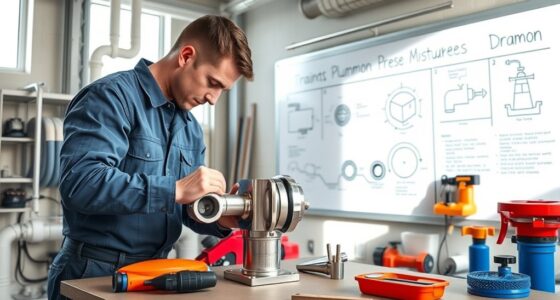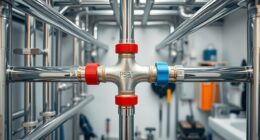To shut off the water supply safely before installation, locate your main shut-off valve, usually near the water meter in your basement, garage, or utility area. Turn the valve clockwise to stop the flow, using gentle force or lubricant if it’s stubborn. Make sure the water is fully off before starting your work. If you’re unsure about the valve type or encounter issues, there’s more you should consider to make certain of a safe and effective shut-off.
Key Takeaways
- Locate the main shut-off valve, typically near the water meter or in the basement or utility area.
- Identify the valve type (ball, gate, globe) to operate it safely and efficiently.
- Turn the valve clockwise gently to close; avoid forcing to prevent damage or leaks.
- Drain remaining water by opening a faucet downstream to relieve pressure before installation.
- Confirm water flow has stopped before beginning installation to ensure safety and prevent water damage.

Shutting off the water supply is a essential step when you’re repairing plumbing, fixing leaks, or preparing for emergencies. Knowing how to do it properly guarantees your safety and prevents water damage. The first thing you need to understand is the different valve types available. The most common are ball valves, gate valves, and globe valves. Ball valves are popular because they operate with a simple quarter-turn, making them quick to shut off and highly reliable. Gate valves, on the other hand, require you to turn a wheel to raise or lower a gate inside the valve, which can take longer but provides a tight seal. Globe valves are often used for controlling flow rather than shutting off water completely, but they can be used in emergency situations if needed. Recognizing these types helps you select the right valve for your setup and operate it correctly.
Before you start shutting off the water, it’s essential to familiarize yourself with your home’s shut-off procedures. Most homes have a main shut-off valve located near the water meter, usually in a basement, garage, or utility area. In an emergency, quick access to this valve is paramount. You should know whether the valve is a ball valve, gate valve, or another type, so you can operate it swiftly. Always turn the valve clockwise to shut it off; avoid forcing it if it’s stuck—try gently working it back and forth or applying some lubricant if necessary. If your main valve is difficult to operate or corroded, consider consulting a plumber for repairs or upgrades.
In emergency procedures, time is critical. If you notice a burst pipe or severe leak, shutting off the water quickly can minimize damage. Keep a wrench or a pair of pliers nearby that can help you operate the valve if it’s hard to turn by hand. If you have a multi-valve system or separate shut-offs for different fixtures, know which valve controls which part of your home. This allows you to isolate the problem area without shutting off the entire water supply. Always double-check that the water has stopped flowing before beginning repairs. It’s also wise to drain excess water from the pipes by opening nearby faucets, so pressure is relieved and leaks are minimized during your work.
Frequently Asked Questions
Can I Shut off the Water Supply Without Turning off the Main Valve?
Yes, you can shut off the water supply without turning off the main valve by using alternative valve options like individual shutoff valves for specific fixtures. Emergency shutoff methods include locating and closing these valves quickly. Keep in mind, these options work best for localized repairs or installations, but for complete control and safety, the main valve remains the most dependable shutoff method. Always ensure you know the location of these valves beforehand.
How Long Does It Take for the Water to Fully Stop After Shutting Off?
Once you shut off the valve, it typically takes a few seconds to a minute for the water to fully stop flowing, depending on your home’s water pressure and flow rate. Higher water pressure or flow rate can cause a slight delay. To guarantee complete stoppage, watch the fixture for drips or leaks, and give it a moment to confirm the water has ceased before starting your installation.
What Should I Do if the Water Supply Doesn’t Shut off Completely?
Did you know that about 15% of plumbing repairs involve valve malfunctions? If the water supply doesn’t shut off completely, you should first check for water pressure issues that could keep water flowing. If the valve seems faulty, turn off the main water supply immediately and consider calling a professional plumber. Don’t force the valve, as this could cause further damage or leaks.
Is It Necessary to Drain the Pipes After Shutting off the Water?
Yes, draining the pipes is necessary after shutting off the water supply, especially for pipe maintenance or emergency shutoff. You should open faucets at the lowest point in your home to let remaining water drain out, preventing pressure buildup and leaks. This step helps protect your pipes from damage during maintenance or emergencies. Always guarantee all water is drained to avoid water damage and make repairs safer and easier.
Are There Different Procedures for Shutting off Water in Multi-Story Buildings?
Sure, shutting off water in multi-story buildings isn’t the same as turning off a faucet. You follow specific Building Regulations and Emergency Procedures to guarantee safety and prevent damage. You might need to isolate certain floors or sections, coordinate with building management, and use specialized valves. It’s more complex, but ignoring these procedures risks flooding or violating regulations. So, always plan carefully and follow established protocols.
Conclusion
Now that you know how to shut off the water supply safely, it’s almost like the universe conspired to prepare you for this moment. As you turn the valve, you might notice a small coincidence—a tiny leak or a sudden silence—that reminds you how everything aligns perfectly for a smooth installation. With this simple step done, you’re one confident homeowner closer to completing your project. Sometimes, the universe just makes things fall perfectly into place, doesn’t it?









